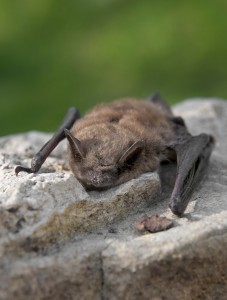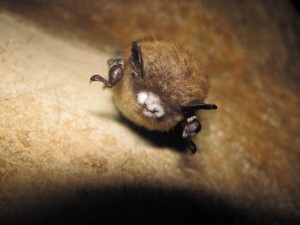Myotis Bat Emergency Listing

The Government of Canada recently added 3 bat species to Schedule 1 of the Species at Risk Act (SARA), otherwise known as the official national list of wildlife species at risk. The three bat species – the Little Brown Myotis, Tri-coloured Bat, and Northern Myotis – are now under federal protection because of White-nose Syndrome (WNS), an epidemic that is decimating North American bat populations.
White-nose syndrome is a fungal infection of the skin that expresses itself as white fuzzy growths on the nose, mouth, ears, and wings of a bat – hence its name. The fungus, called Pseudogymnoascus destructans, is actually best suited to grow in cool environments such as winter bat caves – called hibernacula. Once infected, the fungus causes the bats to awaken from their hibernation more easily, significantly depleting their built-up energy stores. This exhaustion of fat stores results in the bats starving to death because they run out of energy before they are able to feed again in the spring. This disease has killed up to 90% of some regions’ bat populations throughout northeastern North America. The Little Brown Myotis, Northern Myotis, and Tri-coloured Bat were once very common but with the spread of WNS, they are now considered endangered at a national level. Some provinces, including Ontario, have also listed these species as endangered under provincial species at risk legislation.
In February 2012, the Committee on the Status of Endangered Wildlife in Canada (COSEWIC) conducted an emergency assessment on the three bat species to determine if their official legal status should be upgraded to “endangered”. Following COSEWIC’s recommendation that the Environment Minister issue an Emergency Order to protect the imperiled bats, the Government of Canada finally added the species to Schedule 1 of SARA on November 26, 2014 – 2 years following COSEWIC’s recommendation.
WNS first appeared in New York State in 2006 and has since spread into Canada and throughout the United States. Today, White-nose Syndrome has been confirmed in Nova Scotia, New Brunswick, P.E.I, Ontario, and Quebec, as well as 25 US states.

Little Brown Myotis (iStock)
Photo by US Fish & Wildlife Service
Fortunately, the fungus has not (yet) appeared in any other Canadian provinces, but nevertheless it continues to spread between bat hibernacula within the 5 eastern provinces where it has been confirmed. There is no cure for this fungal infection and in an effort to stem the spread of this lethal infection, provinces are closing bat caves to the public (including climbers) as the disease is thought to be spread in part by humans. Humans cannot contract the disease.
In Canada, federal land accounts for on average just 5% of the total area of each province, meaning that provincial governments have a significant role in conserving these misunderstood and under-appreciated species. Some provinces committed to giving these species protection as soon as the full impact of WNS started to become known. However other provinces, such as PEI, have not yet given their affected bat species protection, further jeopardizing local populations of these important animals.
Because there is no known cure, there is not much we can do in terms of saving the bats that have contracted WNS. But we can help by preventing the spread of the disease. Humans are suspected of being capable of spreading WNS spores on clothing and gear, so avoid going into caves that have bats in them. If you need to go into a bat cave – and you have appropriate permission to do so – be sure to disinfect all of your clothing and gear before and after you entering the cave. This will ensure that humans do not spread the disease.

Bat with White-nose Syndrome
Photo by US Fish & Wildlife Service
One of the most important things we can do is to get over the stigma that bats are harmful animals. Bats – even the species that feed on blood – are harmless to humans. While bats are capable of carrying rabies, the US Centers for Disease Control reports that less than 6% of all tested bats actually carry the disease – that is, VERY FEW bats actually carry rabies. More importantly, bats eat the insects that plague our crops, forests and us – thereby saving famers, governments and homeowners millions of dollars in pesticides and pest control each year. A single bat can eat over 1,000 small flying insects in just one hour. Just think of what a camping trip or evening on the lake might be like without any bats around…
Perhaps once we have overcome the ‘evil’ brand we have placed on bats, we can help restore and maintain their populations, and accept bats as ‘friend’ instead of ‘foe’. And stay tuned to Nature Canada’s NatureHood program to learn how we’ll be engaging people in bat monitoring through our seasonal NatureBlitz events!



